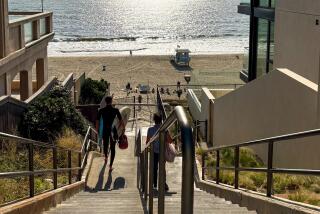One Pragmatic Path : Aesthetics of Arroyo Simi Bicycle Route Prove Secondary to Its Utility as a Way Around Town
- Share via
Running parallel to Simi Valley’s central storm drain, the Arroyo Simi Bicycle Path is unlikely to inspire euphoria among cycling purists, even when all seven miles are completed by the end of the summer.
Providing little in the way of aesthetics, the path rolls alongside algae-gurgling water, passes apartment complexes and abandoned shopping carts and occasionally dips underneath concrete bridges. It also offers an unsatisfying ride--the longest continuous section is only 2.2 miles, and cyclists are required to make several dismounts to cross heavily trafficked city streets.
“This path is not for die-hard serious cyclists,” admitted Dmitri Hunt, an administrator who handles the bike path for the city’s Rancho Simi Recreation and Park District.
The path’s utilitarian status, however, is all right with Hunt. One of the region’s first storm-drain bikeways--L.A.’s is still in the planning stages--the path is not designed to delight cycling purists but to encourage people to take bicycles instead of cars on intracity jaunts.
Designated as a Class 1 bike route by the Ventura County Transportation Commission, the path is primarily for commuters going to and from work or school and “for families and people running errands,” Hunt said.
The path does have a basic appeal for recreational riders who live in the area, but it probably doesn’t draw too many cyclists from outside Simi Valley.
“Stopping and dismounting is a hassle,” said Sean Philkins, a 16-year-old rider, “but I still like (the path) pretty much. I just moved (to Simi Valley) from Florida, and there’s nothing even close to this down there.”
Using right of way secured from the Ventura County Flood Control District, Simi Valley has been cobbling the path together for nearly a dozen years. The process has been slow.
“It hasn’t been easy identifying funds for the path,” Hunt said. “Ball fields and picnic areas always seem to take priority.”
Only about 4.5 miles have been built, but another 2.25 miles are expected to be finished by the fall, creating a route that begins at Madera Road and goes east all the way to Stearns Street.
The bulk of the construction money is a $478,000 grant from Proposition 116, which is supposed to spark interest in alternative forms of transportation in California.
To illustrate how recreation was a minor consideration in building the path, Simi Valley probably got the grant because its bid proposed a 500-foot extension connecting the path to a Metrolink station. The station, which is scheduled to open this fall for rail commuters to Los Angeles, will have storage facilities for bikes.
Because of unreliable measuring devices, Hunt said, the city cannot accurately gauge how many riders currently use the path. When the final sections are done this summer, he projects 2,000 riders a month.
Eventually, the city hopes to add another two miles to the path from Stearns east to Kuehner Drive, which would effectively extend it from one end of Simi Valley to the other.
It’s also feasible to extend the path west into Moorpark, but “that seems a little far off,” Hunt said. “It would involve cooperation with Moorpark and the county.”
Unfortunately, it doesn’t look as if the current path can be diverted under bridges to avoid the detours across main thoroughfares. Only the bridges at First Street had enough clearance to accommodate the path.
“We’re fairly constricted in what we can do,” Hunt said. “But we’re actually fortunate as it is. You can span pretty much the whole valley with only four or five crossings. That’s not too bad.”
More to Read
Sign up for Essential California
The most important California stories and recommendations in your inbox every morning.
You may occasionally receive promotional content from the Los Angeles Times.













